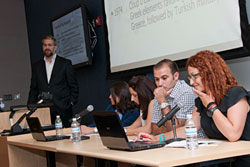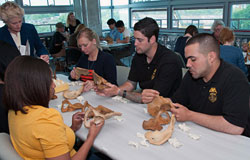NMHM Holds 25th Annual Forensic Anthropology Course, Science Café Program Featuring Forensic Professionals from Cyprus
June 29, 2012, Silver Spring, Md.: Brian Spatola, Anatomical Collections Manager at the National Museum of Health and Medicine (NMHM), and Franklin Damann, Anatomical Collections Curator at NMHM, recently oversaw the Museum's 25th Annual Forensic Anthropology Course at the Maryland Office of the Chief Medical Examiner (OCME) in Baltimore, Md. After the course, Damann organized a Museum Science Café featuring staff from the Committee on Missing Persons in Cyprus.
|
The course provides an overview of the practice of forensic anthropology, which is concerned with the scientific recovery, analysis and identification of human remains in the medicolegal context. The 30 attendees learned about the methods forensic anthropologists use to create a biological profile of unidentified remains for human identification, discussed methods and challenges in remains location and recovery, participated in hands-on lab sessions to learn about basic techniques of skeletal analysis, and more. "Sharing the expertise of the Museum staff and interacting with academic and applied professionals as well as students continues to emphasize to me just how important the museum is for physical anthropology and the forensic sciences," Spatola said. "These audiences have also provided ideas for additional roles the museum can play in medical and forensic education, such as digitizing study materials for university teaching and establishing new internship opportunities that take advantage of our new location and improved facilities." Thomas Mauriello, a lecturer at the University of Maryland's Department of Criminology and Criminal Justice and a consultant in criminalistics, said he attended the course to improve his knowledge of forensic anthropology. He added that he teaches an undergraduate forensic science course and also assists lawyers with cases involving forensic evidence. "The course has been very valuable," he said while participating in a lab session on June 14. "I've gotten the knowledge and facts that I hoped to get out of it." The course relies on support from several agencies including the Henry M. Jackson Foundation for the Advancement of Military Medicine, Inc., the Armed Forces Medical Examiner System, the National Museum of Health and Medicine, the Maryland OCME and the Uniformed Services University of the Health Sciences. The Armed Forces Medical Examiner System provided 30 continuing medical education credits for participants. The course has provided training in forensic anthropology to forensic pathologists, coroners and associated investigators and specialists for 25 years, Spatola said. "It is rare for me to meet a Chief ME or experienced forensic pathologist who did not take the course early in their career," he said. "In many instances, these are the medical examiners that have taken additional steps to integrate forensic anthropologists into their day-to-day operations by employing anthropologists within their agencies, rather than only using them as consultants. Also, the opportunity to learn using a broad array of documented skeletal specimens is not found in any other course of this type." The course was also attended by four members of the scientific staff of the Committee on Missing Persons (CMP) in Cyprus. On June 19, Damann, who worked with the CMP for a year, and the CMP scientific staff members gave an in-depth talk at Montgomery College's Health Sciences Institute and Center in Silver Spring about their work recovering and identifying missing persons in Cyprus. The CMP investigates cases of persons reported missing as a result of armed conflict during the 1960s and 1970s. A total of 502 Turkish Cypriots and 1,493 Greek Cypriots were officially reported as missing. |
 Franklin Damann, Anatomical Collections Curator at the National Museum of Health and Medicine (NMHM), and scientific staff members from the Committee on Missing Persons (CMP) in Cyprus give an in-depth talk at Montgomery College’s Health Sciences Institute and Center in Silver Spring on June 19, 2012 about their work recovering and identifying missing persons in Cyprus. Damann worked with the CMP for a year in Cyprus. (from left to right: Franklin Damann, Maria Chrystalla Kyrkimtzi, Istenç Engin, Erdinç Usta and Maria Constantinou)  Participants in the National Museum of Health and Medicine’s 25th Annual Forensic Anthropology Course at the Maryland Office of the Chief Medical Examiner (OCME) in Baltimore, Md., listen to forensic anthropologist Diane France as they examine skeletal material in a hands-on workshop for medicolegal investigators. The course, which was held June 11-15, 2012, is supported by several agencies including the Henry M. Jackson Foundation for the Advancement of Military Medicine, Inc., the Armed Forces Medical Examiner System, the National Museum of Health and Medicine, the Maryland OCME and the Uniformed Services University of the Health Sciences. |
|
The staff members, Istenç Engin, Maria Chrystalla Kyrkimtzi, Erdinç Usta and Maria Constantinou, explained that the primary purpose of the project is to enable relatives of missing persons to recover the remains of their loved ones and arrange for a proper burial. They stated that the project is strictly humanitarian— when they recover a body, they do not determine the cause of death or responsibility for the death. Bodies have been found individually or in groups in the mountains, limekilns, wells, archaeological sites, front yards of houses, among other places, Usta said. Once the bones are excavated, they are taken back to the CMP Anthropological Lab where they are photographed, cleaned, laid out in anatomical order (if possible) and a biological profile is created. The anthropologists also check the bones for marks of pathology, which may be helpful in identifying the remains, and also take stock of any personal items (such as wedding rings or ID cards) that were found with the remains. One of the last phases is obtaining a DNA sample from the body. Genetic profiles generated by the analysis of DNA extracted from skeletal elements are compared with the genetic profiles of the relatives of missing persons to reveal individualized identifications. The first skeletal specimens of the CMP project were submitted for genetic analysis at the beginning of April 2007 and were identified by the end of June 2007, according to the CMP's website. When an identification is made, the remains are returned to the relatives of the deceased. Kyrkimtzi said CMP staff as well as a psychologist is on hand to meet with them. To date, 853 sets of remains have been received at the CMP Anthropological Laboratory. Of those 853 sets, 529 sets have been analyzed at the CMP lab and 321 missing individuals have been returned to their families (255 missing Greek Cypriots and 66 missing Turkish Cypriots). Engin said residents have been appreciative of their work and have provided assistance when needed. Terence Taylor, president of the International Council for the Life Sciences, said he found the program to be "extremely informative." "I was very interested in the methodology concerned with the forensic sciences," he said. "And I also had particular interest in the topic as I was stationed in Cyprus with the British Armed Forces various times in the 1960s and 1970s." |
|
Resources:
- The National Museum of Health and Medicine: www.medicalmuseum.mil
- The Henry M. Jackson Foundation for the Advancement of Military Medicine, Inc.: www.hjf.org
- Armed Forces Medical Examiner System: health.mil/afmes
- The Maryland Office of Chief Medical Examiner: dhmh.maryland.gov/ocme/
- Uniformed Services University of the Health Sciences: www.usuhs.mil
- Committee on Missing Persons in Cyprus: www.cmp-cyprus.org
About the National Museum of Health and Medicine
- The National Museum of Health and Medicine, established in 1862, inspires interest in and promotes the understanding of medicine -- past, present, and future -- with a special emphasis on tri-service American military medicine. As a National Historic Landmark recognized for its ongoing value to the health of the military and to the nation, the Museum identifies, collects, and preserves important and unique resources to support a broad agenda of innovative exhibits, educational programs, and scientific, historical, and medical research. The Museum has relocated to 2500 Linden Lane, Silver Spring, Md., 20910. Visit the Museum website at www.medicalmuseum.mil or call (301) 319-3300.



